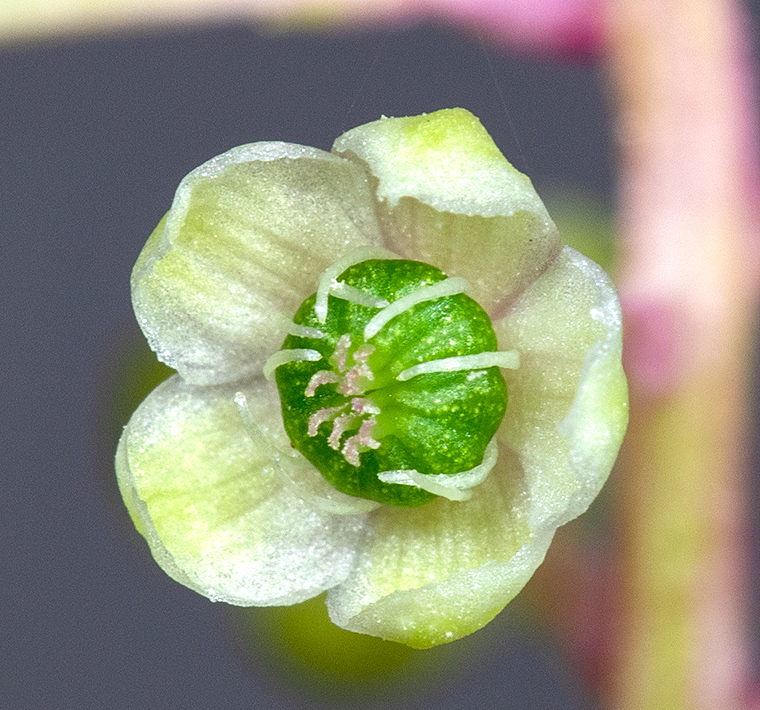 I bet you cannot guess the plant from which this flower was photographed.
I bet you cannot guess the plant from which this flower was photographed.
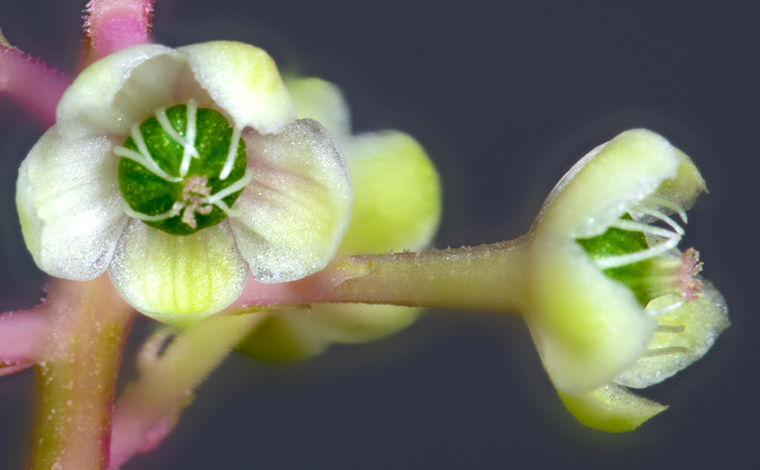 The flower is very small, maximum diameter is only about 1/4 inch. Each flower has a very large, compound green ovary in the center. The ovary has ten small, brush-like stigmas on top. Ten pale, filamentous anthers surround the ovary, and there are five pale green petal-like sepals around the edge of the flower. The flower on the right shows the bushy ends of the stigmas.
The flower is very small, maximum diameter is only about 1/4 inch. Each flower has a very large, compound green ovary in the center. The ovary has ten small, brush-like stigmas on top. Ten pale, filamentous anthers surround the ovary, and there are five pale green petal-like sepals around the edge of the flower. The flower on the right shows the bushy ends of the stigmas.
The flowers come in spikes like the one pictured above.
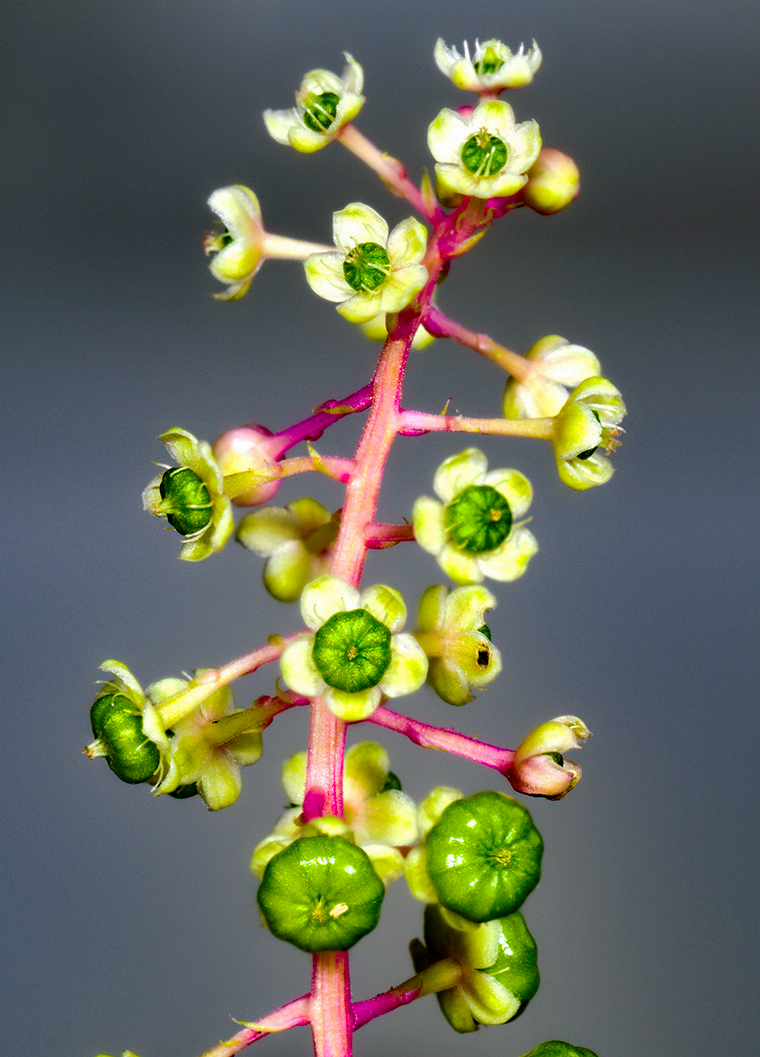 After fertilization, the ovaries begin to swell, and the anthers and stigmas are gradually lost.
After fertilization, the ovaries begin to swell, and the anthers and stigmas are gradually lost.
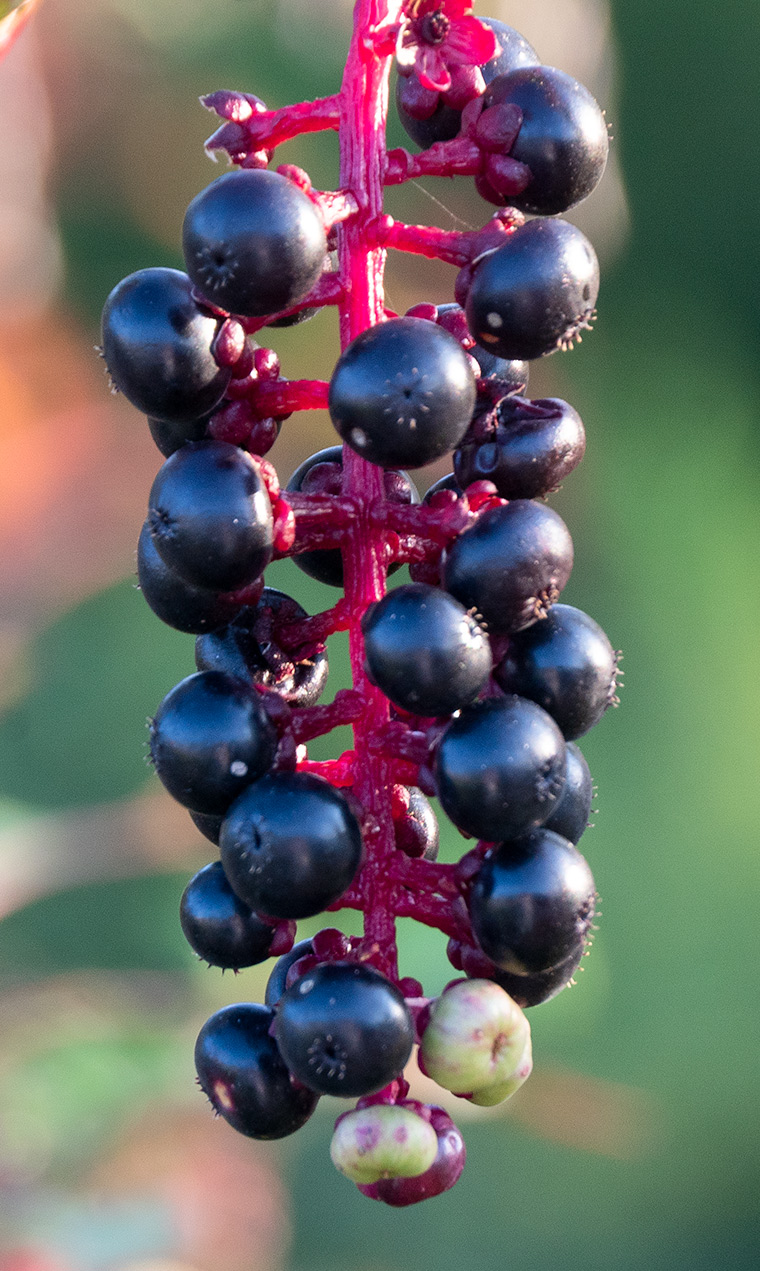 Each of the originally green ovaries, if fertilized, continues to swell and turn a deep purple in color. The resultant fruit is now called a “berry”. You probably know by now that this plant is Pokeweed (Phtolacca americana). It is a common plant, usually regarded as a weed, over much of the Eastern United States.
Each of the originally green ovaries, if fertilized, continues to swell and turn a deep purple in color. The resultant fruit is now called a “berry”. You probably know by now that this plant is Pokeweed (Phtolacca americana). It is a common plant, usually regarded as a weed, over much of the Eastern United States.
The photograph to the left is a closeup of a few berries. The flower just above the berries illustrates the relative size of a flower and the resultant berry. Note also, that the sepals that originally surrounded the flower are still present below each berry, but are now a deep purple color.
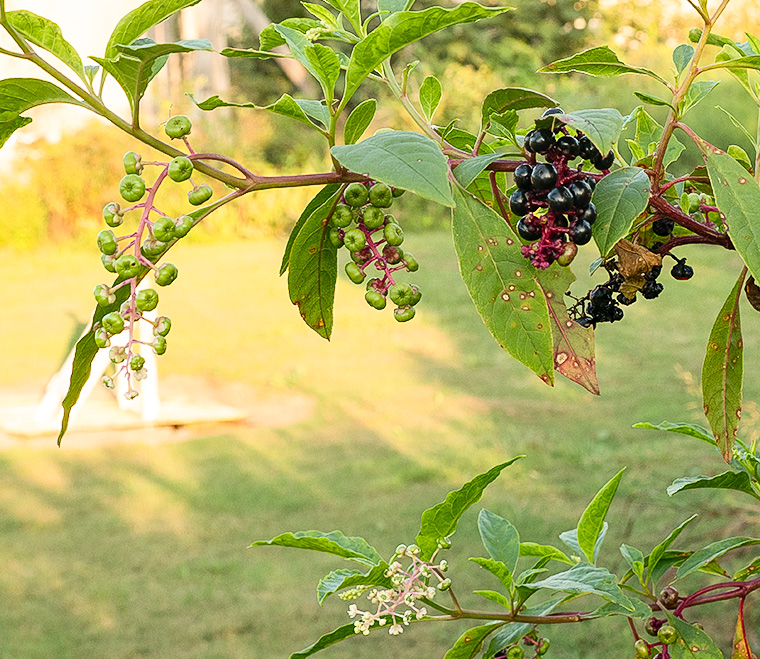 The photograph above shows one branch of a Pokeweed plant. I include it to show that all stages of the plant from flowers to berries are simultaneously present on plants.
The photograph above shows one branch of a Pokeweed plant. I include it to show that all stages of the plant from flowers to berries are simultaneously present on plants.
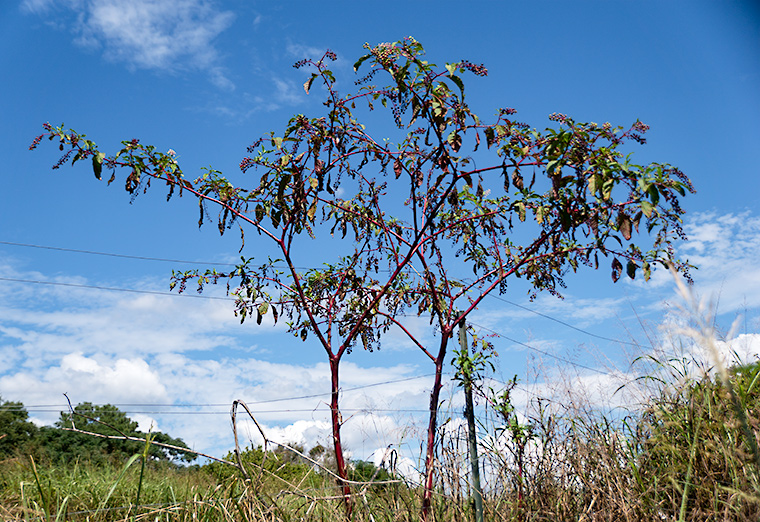 This is a photograph of an entire plant growing in its usual habitat in this area, a fence row. The plant is about 5 feet tall. Such plants typically show a red tint over the entire plant. All stages in the development of the flowers and berries are still present.
This is a photograph of an entire plant growing in its usual habitat in this area, a fence row. The plant is about 5 feet tall. Such plants typically show a red tint over the entire plant. All stages in the development of the flowers and berries are still present.
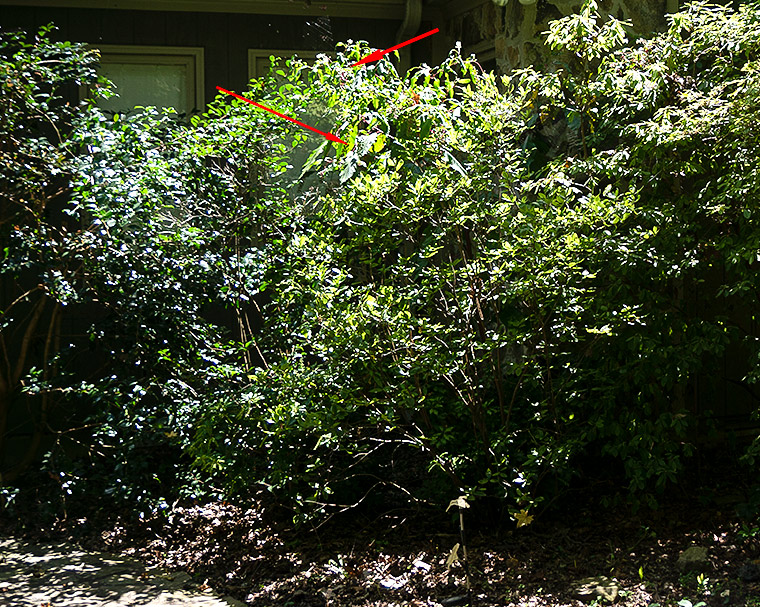 Here is a rather more favorable habitat for Pokeweed growth. Can you see the Pokeweed among the wild azaleas we have planted. The red arrows point out the large leaves and the developing fruit of the pokeweed.
Here is a rather more favorable habitat for Pokeweed growth. Can you see the Pokeweed among the wild azaleas we have planted. The red arrows point out the large leaves and the developing fruit of the pokeweed.
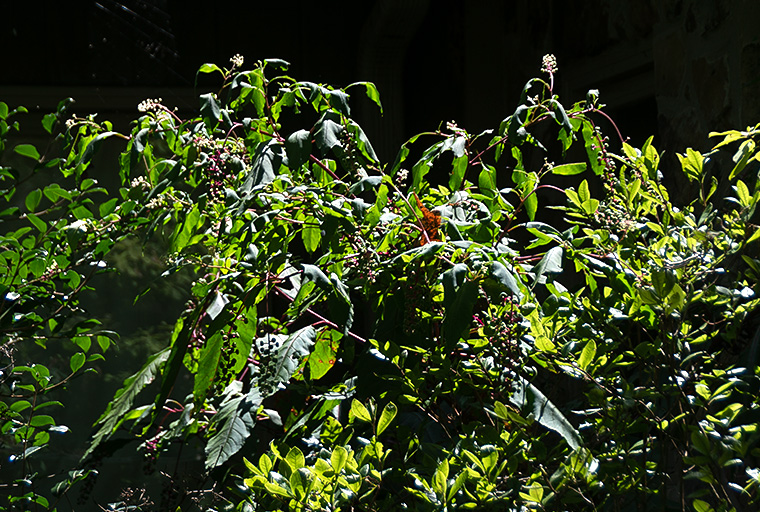 The photograph above is a closer view of the Pokeweed among the azaleas.
The photograph above is a closer view of the Pokeweed among the azaleas.
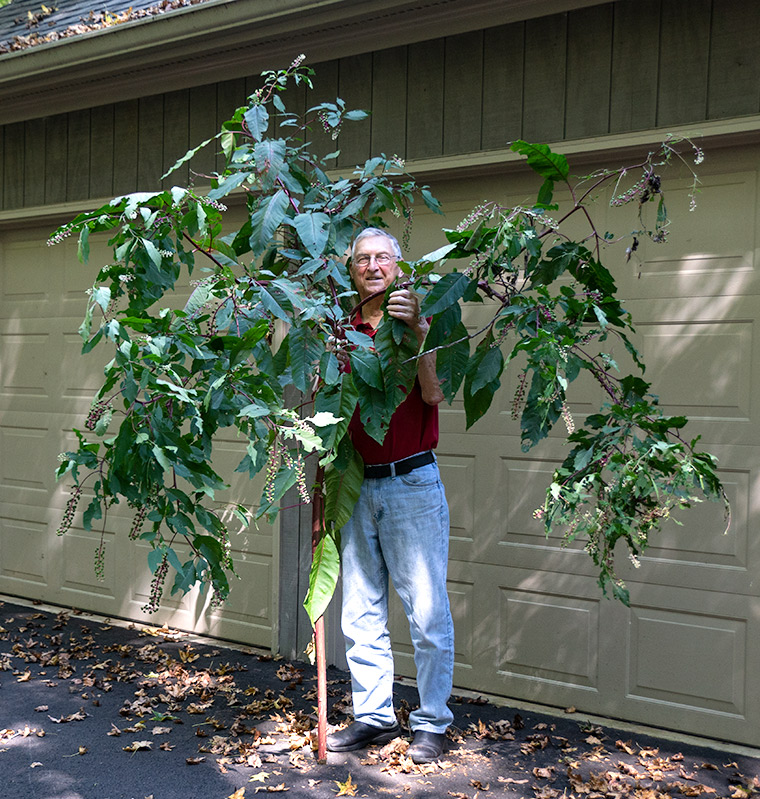 This photograph shows the Pokeweed plant that was growing among our wild azaleas. We have been watching this Pokeweed plant grow all summer. Most of the photographs in this post were taken using material from this plant. Pokeweed is a perennial, so we will probably have a repeat offender in the same place next year.
This photograph shows the Pokeweed plant that was growing among our wild azaleas. We have been watching this Pokeweed plant grow all summer. Most of the photographs in this post were taken using material from this plant. Pokeweed is a perennial, so we will probably have a repeat offender in the same place next year.
Pokeweed is quite an interesting plant, and a lot of literature has been written about it. I will just mention a few of the main features in this post. If you want more, just do a web search or look in some relevant books.
Edibility vs. Toxicity: All parts of the plant contain toxins and should not be eaten unless one knows the special methods of preparation needed to detoxify the plant parts, Despite potential dangers, Poke Sallet (or Salad), made from pealed stems and leaves is a traditional Southern dish. Toxins are removed by boiling in three changes of water and carefully draining the water each time. Many people prefer to eat the green shoots that first emerge during the beginning of the growing season, as these are the least toxic parts of the plant. These berries are very toxic and should not be eaten under any circumstances.
Ink and Dye: Crushed pokeberries have been used to make ink for a long time. During the Revolutionary War, for example, soldiers wrote letters home using Pokeberry ink. However this ink fades if exposed to light, so it was not a very permanent solution. Some recipes for its preparation can be found a this site.
Properly prepared, pokeberries can produce a red, fuchsia or pink dye. However the color in these dyed fabrics may be sensitive to light. Lots of sites on the web have dye recipes. Here is one such.
Herbal Medicine: Literature on this topic is voluminous, Various parts of the plant are said to be emetic, purgative, good against rheumatism, and stimulate the immune system, It can be used to treat edema, skin cancers, catarrh, dysmenorrhea, mumps, ringworm, scabies, tonsillitis, and syphilis. Wow! A wonder plant indeed. Needless to say, none of these uses have been tested in controlled medical tests. Details about the Pokeweed compounds with potential medical value can be found here.

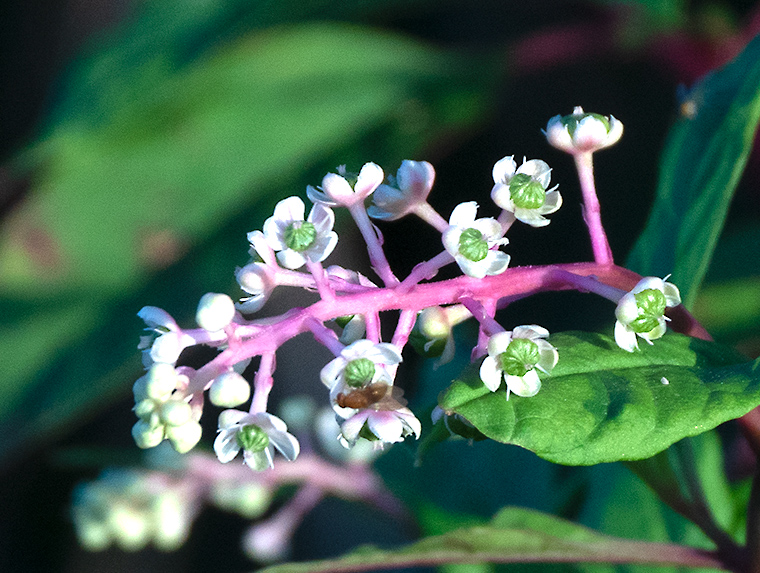
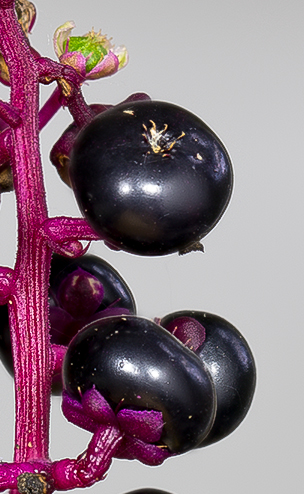
Very informative information. I’ve seen many in my 77 years!